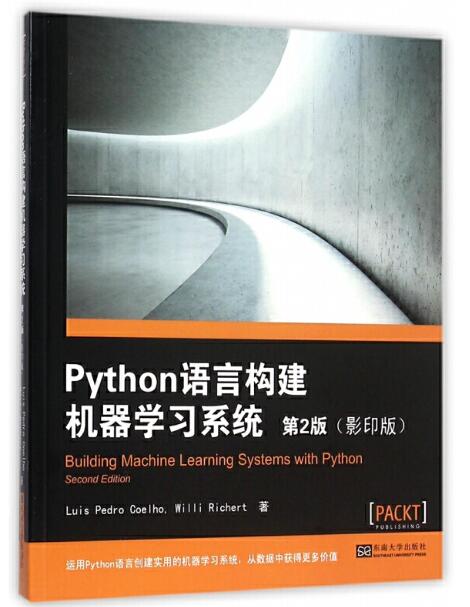
资料简介:
运用机器学习获得对于数据的深入洞见,是现代应用开发者和分析师的关键技能。Python是一种可以用于开发机器学习应用的 语言。作为一种动态语言,它可以进行快速探索和实验。利用其 的开源机器学习库,你可以在快速尝试很多想法的同时专注于手头的任务。 科埃略、里克特所著的《Python语言构建机器学 统(第2版影印版)(英文版)》展示了如何在原始数据中寻找模式的具体方法,从复习Python机器学习知识和介绍程序库开始,你将很快进入应对正式而真实的数据集项目环节,运用建模技术,创建 系统。然后,该书介绍了主题建模、篮子分析和云计算等 主题。这些内容将拓展你的能力,让你能够创建大型复杂系统。 有了这本书,你就能获得构建自有系统所需的工具和知识, 化解决实际的数据分析相关问题。
资料目录:
Preface
Chapter 1: Getting Started with Python Machine Learning
Machine learning and Python - a dream team
What the book will teach you (and what it will not)
What to do when you are stuck
Getting started
Introduction to NumPy, SciPy, and matplotlib
Installing Python
Chewing data efficiently with NumPy and intelligentlywith SciPy
Learning NumPy
Indexing
Handling nonexisting values
Comparing the runtime
Learning SciPy
Our first (tiny) application of machine learning
Reading in the data
Preprocessing and cleaning the data
Choosing the right model and learning algorithm
Beforebuilding our first model...
Starting with a simple straight line
Towards some advanced stuff
Stepping back to go forward - another look at our data
Training and testing
Answering our initial question
Summary
Chapter 2: Classifying with Real-world Examples
The Iris dataset
Visualization is a good first step
Building our first classification model
Evaluation - holding out data and cross-validation
Building more complex classifiers
A more complex dataset and a more complex classifim
Learning about the Seeds dataset
Features and feature engineering
Nearest nei or classification
Classifying with scikit-learn
Looking at the decision boundaries
Binary and multiclass classification
Summary
Chapter 3: Clustering - Finding Related Posts
Measuring the relatedness of posts
How not to do it
How to do it
Preprocessing - similarity measured as a similar number of common words
Converting raw text into a bag of words
Counting words
Normalizing word count vectors
Removing less important words
Stemming
Stop words on steroids
Our achievements and goals
Clustering
K-means
Getting test data to evaluate our ideas on
Clustering posts
Solving our initial challenge
Another look at noise
Tweaking the parameters
Summary
Chapter 4: Topic Modeling
Latent Dirichlet allocation
Building a topic model
Comparing documents by topics
Modeling the whole of Wikipedia
Choosing the number of topics
Summary
Chapter 5: Classification - Detecting Poor Answers
Sketching our roadmap
Learning to classify classy answers
Tuning the instance
Tuning the classifier
Fetching the data
Slimming the data down to chewable chunks
Preselection and processing of attributes
Defining what is a good answer
Creating our first classifier
Starting with kNN
Engineering the features
Training the classifier
Measuring the classifier's performance
Designing more features
Deciding how to improve
Bias-variance and their tradeoff
Fixing high bias
Fixing high variance
High bias or low bias
Using logistic regression
A bit of math with a small example
Applying logistic regression to our post classification problem
Looking behind accuracy- precision and recall
Slimming the classifier
Ship it!
Summary
Chapter 6: Classification II - Sentiment Analysis
Sketching our roadmap
Fetching the Twitter data
Introducing the Naive Bayes classifier
Getting to know the Bayes' theorem
Being naive
Using Naive Bayes to classify
Accounting for unseen words and other oddities
Accounting for arithmetic underflows
Creating our first classifier and tuning it
Solving an easy problem first
Using all classes
Tuning the classifier's parameters
Cleaning tweets
Taking the word types into account
Determining the word types
Successfully cheating using SentiWordNet
Our first estimator
Putting everything together
Summary
Chapter 7: Regression
Predicting house prices with regression
Multidimensional regression
Cross-validation for regression
Penalized or regularized regression
L1 and L2 penalties
Using Lasso or ElasticNet in scikit-learn
Visualizing the Lasso path
P-greater-than-N scenarios
An example based on text documents
Setting hyperparameters in a principled way
Summary
Chapter 8: Recommendations
Rating predictions and recommendations
Splitting into training and testing
Normalizing the training data
A nei orhood approach to recommendations
A regression approach to recommendations
Combining multiple methods
Basket analysis
Obtaining useful predictions
Analyzing supermarket shopping baskets
Association rule mining
More advanced basket analysis
Summary
Chapter 9: Classification - Music Genre Classification
Sketching our roadmap
Fetching the music data
Converting into a WAV format
Looking at music
Decomposing music into sine wave components
Using FFT to build our first classifier
Increasing experimentation agility
Training the classifier
Using a confusion matrix to measure accuracy in
multiclass problems
An alternative way to measure classifier performance
using receiver-operator characteristics
Improving classification performance with Mel
Frequency Cepstral Coefficients
Summary
Chapter 10: Computer Vision
Introducing image processing
Loading and displaying images
Thresholding
Gaussian blurring
Putting the center in focus
Basic image classification
Computing features from images
Writing your own features
Using features to find similar images
Classifying a harder dataset
Local feature representations
Summary
Chapter 11: Dimensionality Reduction
Sketching our roadmap
Selecting features
Detecting redundant features using filters
Correlation
Mutual information
Asking the model about the features using wrappers
Other feature selection methods
Feature extraction
About principal component analysis
Sketching PCA
Applying PCA
Limitations of PCAand how LDA can help
Multidimensional scaling
Summary
Chapter 12: Bigger Data
Learning about big data
Using jug to break up your pipeline into tasks
An introduction to tasks in jug
Looking under the hood
Using jug for data analysis
Reusing partial results
Using Web Services
Creating your first virtual machines
Installing Python packages on Linux
Running jug on our cloud machine
Automating the generation of clusters with StarCluster
Summary
Appendix: Where to Learn More Machine Learning
Online courses
Books
Question and answer sites
Blogs
Data sources
Getting competitive
All that was left out
Summary
Index

